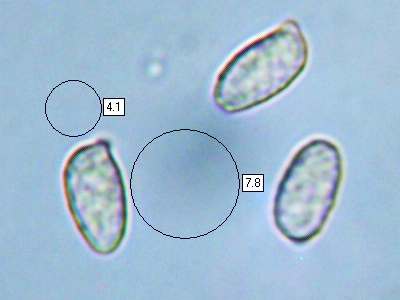Ramaria abietina (Pers.) Quél. - Greening Coral
Phylum: Basidiomycota - Class: Agaricomycetes - Order: Gomphales - Family: Gomphaceae
Distribution - Taxonomic History - Etymology - Identification - Culinary Notes - Reference Sources
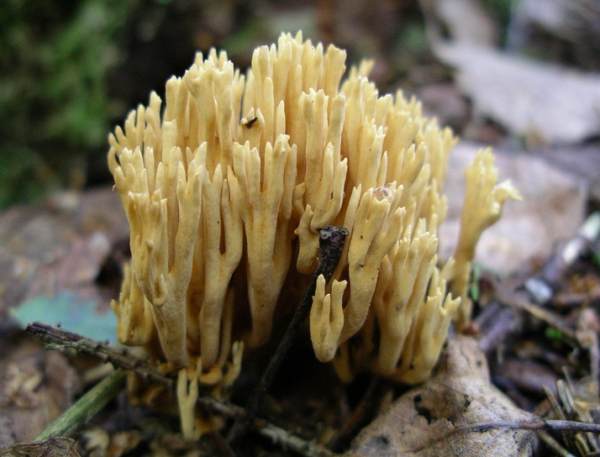
One of the first of the woodland coral fungi, Ramaria abietina can appear as early as June. Often these corals form large arcs and occasionally fairy rings beside the buttress roots of conifers. (Picture Above: Nomeda Vėlavičienė)
Distribution
Ramaria abietina is an occasional find throughout Britain and Ireland; it occurs also throughout most of mainland Europe, from Scandinavia right down to the Mediterranean and the Iberian Peninsula.
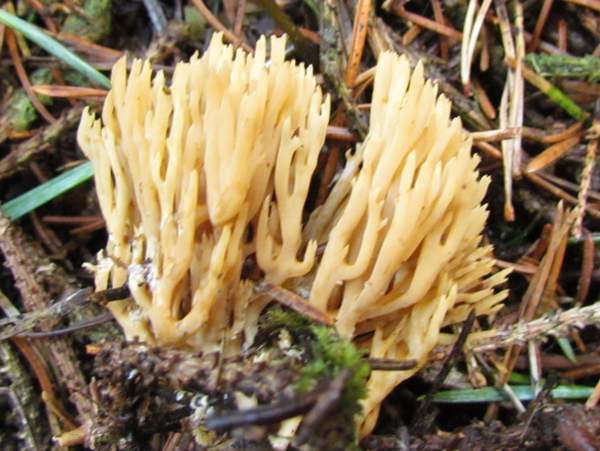
This species occurs in many parts of North America, where it is commonly referred to as the Green-staining Coral and some of the latest field guides list it under the scientific name Phaeoclavulina abietina (Pers.) Giachini (2011).
Taxonomic history
The species was described in 1794 by Christian Hendrik Persoon, who gave it the scientific binomial name Clavaria abietina. French mycologist Lucien Quélet transferred it to the genus Ramaria in 1888, when its scientific name became Ramaria abietina.
Synonyms of Ramaria abietina include Clavaria abietina Pers., Clavaria ochraceovirens Jungh., Ramaria ochraceovirens (Jungh.) Donk, Merisma abietinum (Pers.) Sprengel, Hydnum abietinum (Pers.) Duby, Clavariella abietina (Pers.) J.Schröt., and Phaeoclavulina abietina (Pers.) Giachini.
Etymology
Ramaria, the generic name, comes from Ram- meaning branch, with the suffix -aria meaning possessing or furnished with. Ramaria coral species are indeed furnished with numerous branches.
The specific epithet abietina is derived from the Latin for a fir tree (Abies genus), but this coral seems to favour spruces; however, Picea abies is the scientific name for the Norway Spruce.
Identification guide
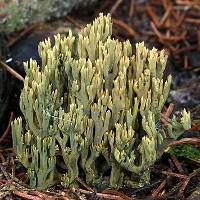 |
FruitbodyRepeatedly branching woodland coral whose final branches terminate in two or three laterally-compressed pointed tips; colour yellowish at first becoming more olive (see picture on the left) at maturity; branches turn greenish when bruised. The pale stout stem is short, mainly buried below the surface of the substrate, and covered in downy white mycelium; tough and fibrous, the flesh is whitish. 2.5 to 5.5cm tall and up to 5cm across the whole fruitbody; often gregarious with several fruitbodies merging. (Picture Above: Holger Krisp, Ulm, Germany, Wikipedia) |
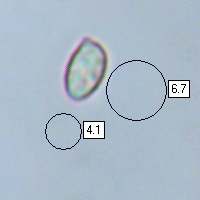 |
SporesBroadly ellipsoidal to pip-shaped, smooth, 6-8 x 4-4.5μm.
Spore printYellowish. |
Odour/taste |
No significant odour but a bitter taste. |
Habitat & Ecological role |
Under conifers, most commonly spruce trees, usually on acidic soil. |
Season |
July to November in Britain and Ireland. |
Similar species |
Ramaria flaccida is typically somewhat larger and it does not bruise greenish. |
Culinary Notes
Ramaria abietina is insubstantial and it is generally considered to be inedible. Note that some coral fungi that look quite similar to Ramaria abietina are known to be poisonous.
Reference Sources
Fascinated by Fungi, 2nd Edition, Pat O'Reilly 2016, reprinted by Coch-y-bonddu Books in 2022.
Dictionary of the Fungi; Paul M. Kirk, Paul F. Cannon, David W. Minter and J. A. Stalpers; CABI, 2008
Taxonomic history and synonym information on these pages is drawn from many sources but in particular from the British Mycological Society's GB Checklist of Fungi.
Fascinated by Fungi. Back by popular demand, Pat O'Reilly's best-selling 450-page hardback book is available now. The latest second edition was republished with a sparkling new cover design in September 2022 by Coch-y-Bonddu Books. Full details and copies are available from the publisher's online bookshop...

